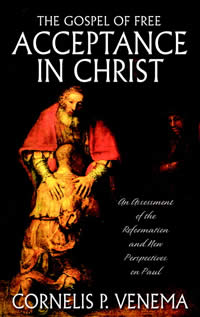Book Review—The Gospel of Free Acceptance in Christ
The Gospel of Free Acceptance in Christ: An Assessment of the Reformation and New Perspectives on Paul by Cornelis P. Venema. Edinburgh: The Banner of Truth Trust, 2006. 352 pp. $28.00/hardback. Purchase: BOT, CBD, WTS Bookstore, Amazon
Purchase: BOT, CBD, WTS Bookstore, Amazon
ISBNs: 0851519393 / 9780851519395
LCCN: BS2655 J8 V46 2006x
DCN: 227 V456g
Special Features: Selected Bibliography, Index of Persons, Index of Selected Subjects, Index of Scripture References.
Subject(s): The Apostle Paul, Justification, New Perspective on Paul
(from the jacket cover)
Cornelis P. Venema is the President of Mid-America Reformed Seminary, Dyer, Indiana, where he also serves as Professor of Doctrinal Studies. He gained his Ph.D. from Princeton Theological Seminary for work on the theology of John Calvin. His books, The Promise of the Future and Getting the Gospel Right, are also published by the Trust.
In his book, The Gospel of Free Acceptance in Christ: An Assessment of the Reformation and New Perspectives on Paul, Cornelis P. Venema seeks to inform readers of a challenge to the traditional understanding of Paul’s doctrine of justification by faith. Some contemporary authors claim that the Protestant Reformers misread Paul’s epistles and taught a wrong doctrine of justification, resulting in the largest division of Christians in the history of the Church. These men, promoting a position called the New Perspective on Paul (NPP), are calling believers to a new understanding of justification which seeks to unify the various branches of the Christian Church.
Venema counsels that “before abandoning the older perspective on Paul in favour of the new, evangelical believers need to understand what it is they are being asked to abandon” and to “take a careful look at the claims of authors who propose a newer and ostensibly better reading of the apostle Paul’s understanding of the gospel” (p. ix). The author provides a well-planned guide to understanding a theological controversy brewing for three decades.
In the preface, Venema states the purposes for his book: to summarize the Reformation’s understanding of justification by faith, to introduce the position known as the new perspective on Paul, and to “assess critically the claims of the new perspective from a biblical and theological standpoint” (p. ix). These are the three major sections of his study.
The author devotes chapter one to the topic of “Justification in Contemporary Discussion,” concerning recent ecumenical discussions on justification between representatives of the Roman Catholic Church and Protestant denominations. Venema observes that while the NPP arose from the realm of biblical theology, “it cannot be properly appreciated without a recognition that it has emerged within a framework of dissatisfaction with the divisions created by the sixteenth-century dispute about justification” (p. 4). Venema believes that this is an important factor in the way the NPP interprets Paul’s teaching on justification (p. 4).
In Part One, “The Reformation Perspective on Paul,” the author provides “a brief sketch of some of the Reformation’s most dominant themes” (p. 28) related to Paul’s teaching on justification. Venema shows the difference between the Reformation and Roman Catholic understanding of justification. Roman Catholicism teaches that justification “includes a process of moral transformation equivalent to what, in evangelical terms, is known as the work of sanctification” (p. 29). The author references Scripture and Protestant confessions to delineate the Reformation view that justification is a free gift from God based on the work of Christ; that it comes to us through the means of faith; and that in justification God reckons, or imputes, the righteousness of Christ to our account.
This section also deals with the question, “Can a lonely faith save?” Venema recounts the Catholic objection that the Reformation view of justification “dangerously undermines the need for good works in the Christian life” (p. 63). He goes on to show how the reformers reconciled the teaching of Paul and James to prove that the faith that justifies produces a life of obedience. Luther’s low opinion of James, which the Catholics used to bolster their objection, is not a Protestant consensus. Venema says that “James received a ‘more positive reception’ in the Reformed tradition of Calvin and others” (endnote 5, p. 87).
In Part Two, “A New Perspective on Paul,” the author acknowledges the changing landscape of new perspective teachings. However, Venema shows the most common features of the NPP by focusing attention on three of its most influential authors: E.P. Sanders, James D.G. Dunn, and N.T. Wright. Venema identifies Sanders as the pivotal figure of the NPP, whose 1977 book, Paul and Palestinian Judaism, is considered the benchmark for studies in the Judaism of Paul’s day, known as Second Temple Judaism. According to Sanders, historical sources indicate that Judaism in the first century emphasized God’s grace in electing His people and was not a legalistic religion, although the people were expected to obey the Law to maintain their status in the covenant. Justification, in Sanders’ view, is how one gets in the covenant.
Dunn and Wright follow Sanders’ lead in insisting that historical sources demand a new reading of Paul. However, Dunn believes that justification by faith “was common to the Judaism of Paul’s day” and referred to “God’s gracious ‘acknowledgment that someone is in the covenant’” (p. 111). What Dunn believes Paul was opposing was not legalism but “the idea that the ‘works of the law’—those observances that particularly distinguish Jews from Gentiles—are necessary badges of covenant membership” (p. 111). Wright concurs with Dunn that justification deals with who is in the family of God and “does not address the issue of how guilty sinners can find favour or standing with God” (p. 125). He does not believe that God’s righteousness is imputed to the justified sinner. To Wright, “it makes no sense whatever to say that the judge imputes, imparts, bequeaths, conveys or otherwise transfers his righteousness to either the plaintiff or the defendant” (p. 127). Wright believes that the righteousness of God refers merely to “God’s own faithfulness to his covenant promise” and is not something bestowed (p. 127). Venema exposes Wright’s ecumenical leanings in his redefining justification as a doctrine that should bring Protestants and Catholics together, not divide them (p. 130).
In Part Three of his book, Venema makes “A Critical Assessment of the New Perspective on Paul.” He notes the intellectual peer pressure put on believers to radically reinterpret Paul’s epistles or risk “being dismissed as the theological equivalent of ‘flat earthers’” (p. 143). Venema answers the claims of NPP authors by “raising several key questions” concerning Sanders’ work in the historical sources, followed by a “defence of several key aspects of the Reformation’s understanding of Paul, which form the focus of the new perspective’s criticism of the older view” (pp. 144-145). The author calls his evaluation of the NPP a “preliminary assessment,” since “a more complete and adequate evaluation would require a far more extended treatment of the issues” (p. 145). However, he provides abundant references to other helps in his endnotes.
The author identifies a weakness in the method of NPP writers: leaning too heavily upon Sanders’ historical study of Second Temple Judaism. He cautions “against the temptation to make the tentative results of such studies the determining factor in our interpretation of biblical texts” (p. 147, author’s emphasis). Having raised some relevant questions concerning NPP claims based on Sanders’ work, Venema goes on to provide informative chapters on key topics such as the “works of the law,” “the righteousness of God,” “imputation of Christ’s righteousness,” and “a final judgment according to works.” For example, are the works of the law only those “boundary markers,” like circumcision, that distinguish Jews from Gentiles; or do they refer to much more? Also, was Paul opposing legalism or only Jewish exclusiveness? After examining several key Scripture passages showing the ways in which the term law is used, Venema concludes that “the Reformation’s understanding of Paul’s arguments ought to be preserved while that of the new perspective ought to be rejected” (p. 200).
In his concluding chapter, Venema states, “This critical assessment of the new perspective argues that it does not offer a truly satisfying alternative to the older, Reformation perspective” (p. 299). The author goes on to say, “We believe that the new perspective profoundly distorts the gospel of free acceptance with God on the basis of the work of Christ” (p. 299). Among the several reasons he gives is that “the carelessness with which writers of the new perspective speak of a final justification on the basis of works threatens the heart of Paul’s gospel, which teaches that the acceptance and standing of believers before God rests on the work of Christ alone” (p. 306).
One feature I found very helpful in this book is the inclusion of summaries at the end of most chapters. Venema keeps the main points in mind by bringing them together after presenting his research. The reader will be thankful for this small amount of repetition. The only limitations I noticed are the author’s self-imposed limitations. He admits that dealing with every issue would take a much longer book, but he provides extra help in his extensive endnotes. Venema employs endnotes at the end of each chapter rather than footnotes. The translation quoted for Scripture references is the English Standard Version.
A confusing printing error needs to be noted. On page 259 the book skips endnote reference number 4 and gives that reference as 5. Two references to endnote 6 follow. If the reference to note 5 is read as 4 and the first reference to note 6 is read as 5, the endnotes seem to correspond properly. This error should be corrected in future editions of the book.
The Gospel of Free Acceptance in Christ is a good primer on the NPP. It is also a timely refresher on the Reformation’s understanding of the gospel. The book can be enjoyed by any serious reader desiring to grasp a difficult theological controversy, but it seems to be aimed mainly at ministers, seminarians, and other leaders in the gospel ministry. The truths defended in this book gave me cause for rejoicing in my own free acceptance in Christ. The doctrines that the NPP denies fill me with hope for my eternal standing with God. Because of inroads the NPP is making, Venema’s warning is legitimate: “At stake is nothing less than the gospel itself, the church’s proclamation of the good news of salvation in Christ” (p. ix).
 Tim Ashcraft is a layman serving in various ministries at Mount Calvary Baptist Church (Greenville, SC), where he and his family are members. As well as teaching in the Adult Sunday School classes he is the editor of the Men’s Ministry’s Man of the Word manual. Tim is a graduate of Tabernacle Baptist Bible College (Greenville, SC) and works at Kohler Company in Spartanburg, SC. He is married to Doris and has two daughters, Becky and Diane. Tim Ashcraft is a layman serving in various ministries at Mount Calvary Baptist Church (Greenville, SC), where he and his family are members. As well as teaching in the Adult Sunday School classes he is the editor of the Men’s Ministry’s Man of the Word manual. Tim is a graduate of Tabernacle Baptist Bible College (Greenville, SC) and works at Kohler Company in Spartanburg, SC. He is married to Doris and has two daughters, Becky and Diane. |
- 35 views


Discussion